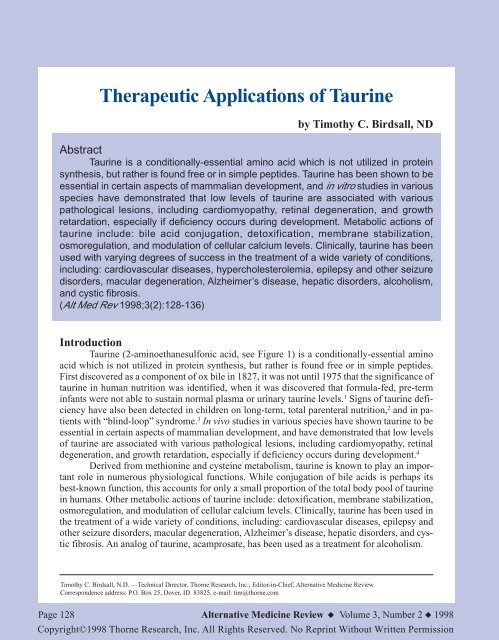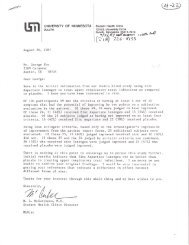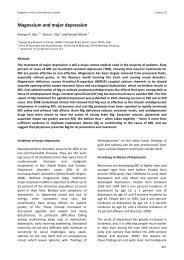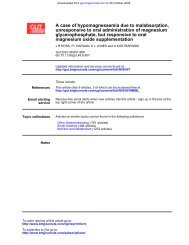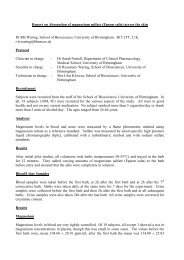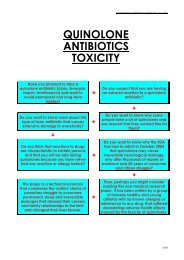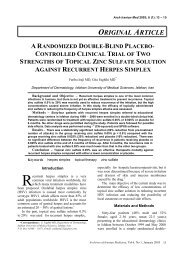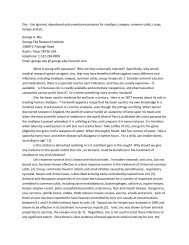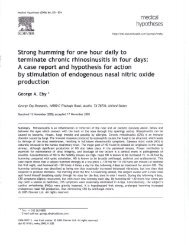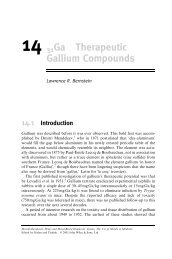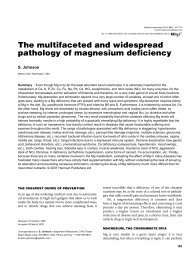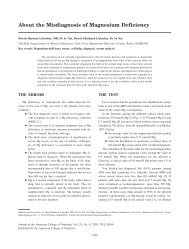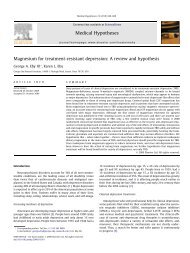Therapeutic Applications of Taurine - George Eby Research Institute
Therapeutic Applications of Taurine - George Eby Research Institute
Therapeutic Applications of Taurine - George Eby Research Institute
Create successful ePaper yourself
Turn your PDF publications into a flip-book with our unique Google optimized e-Paper software.
<strong>Therapeutic</strong> <strong>Applications</strong> <strong>of</strong> <strong>Taurine</strong><br />
by Timothy C. Birdsall, ND<br />
Abstract<br />
<strong>Taurine</strong> is a conditionally-essential amino acid which is not utilized in protein<br />
synthesis, but rather is found free or in simple peptides. <strong>Taurine</strong> has been shown to be<br />
essential in certain aspects <strong>of</strong> mammalian development, and in vitro studies in various<br />
species have demonstrated that low levels <strong>of</strong> taurine are associated with various<br />
pathological lesions, including cardiomyopathy, retinal degeneration, and growth<br />
retardation, especially if deficiency occurs during development. Metabolic actions <strong>of</strong><br />
taurine include: bile acid conjugation, detoxification, membrane stabilization,<br />
osmoregulation, and modulation <strong>of</strong> cellular calcium levels. Clinically, taurine has been<br />
used with varying degrees <strong>of</strong> success in the treatment <strong>of</strong> a wide variety <strong>of</strong> conditions,<br />
including: cardiovascular diseases, hypercholesterolemia, epilepsy and other seizure<br />
disorders, macular degeneration, Alzheimer’s disease, hepatic disorders, alcoholism,<br />
and cystic fibrosis.<br />
(Alt Med Rev 1998;3(2):128-136)<br />
Introduction<br />
<strong>Taurine</strong> (2-aminoethanesulfonic acid, see Figure 1) is a conditionally-essential amino<br />
acid which is not utilized in protein synthesis, but rather is found free or in simple peptides.<br />
First discovered as a component <strong>of</strong> ox bile in 1827, it was not until 1975 that the significance <strong>of</strong><br />
taurine in human nutrition was identified, when it was discovered that formula-fed, pre-term<br />
infants were not able to sustain normal plasma or urinary taurine levels. 1 Signs <strong>of</strong> taurine deficiency<br />
have also been detected in children on long-term, total parenteral nutrition, 2 and in patients<br />
with “blind-loop” syndrome. 3 In vivo studies in various species have shown taurine to be<br />
essential in certain aspects <strong>of</strong> mammalian development, and have demonstrated that low levels<br />
<strong>of</strong> taurine are associated with various pathological lesions, including cardiomyopathy, retinal<br />
degeneration, and growth retardation, especially if deficiency occurs during development. 4<br />
Derived from methionine and cysteine metabolism, taurine is known to play an important<br />
role in numerous physiological functions. While conjugation <strong>of</strong> bile acids is perhaps its<br />
best-known function, this accounts for only a small proportion <strong>of</strong> the total body pool <strong>of</strong> taurine<br />
in humans. Other metabolic actions <strong>of</strong> taurine include: detoxification, membrane stabilization,<br />
osmoregulation, and modulation <strong>of</strong> cellular calcium levels. Clinically, taurine has been used in<br />
the treatment <strong>of</strong> a wide variety <strong>of</strong> conditions, including: cardiovascular diseases, epilepsy and<br />
other seizure disorders, macular degeneration, Alzheimer’s disease, hepatic disorders, and cystic<br />
fibrosis. An analog <strong>of</strong> taurine, acamprosate, has been used as a treatment for alcoholism.<br />
Timothy C. Birdsall, N.D. —Technical Director, Thorne <strong>Research</strong>, Inc.; Editor-in-Chief, Alternative Medicine Review.<br />
Correspondence address: P.O. Box 25, Dover, ID 83825, e-mail: tim@thorne.com<br />
Page 128 Alternative Medicine Review ◆ Volume 3, Number 2 ◆ 1998<br />
Copyright©1998 Thorne <strong>Research</strong>, Inc. All Rights Reserved. No Reprint Without Written Permission
<strong>Taurine</strong><br />
Biochemistry and Metabolism<br />
Although frequently referred to as an<br />
amino acid, it should be noted that the taurine<br />
molecule contains a sulfonic acid group, rather<br />
than the carboxylic acid moiety found in other<br />
amino acids. Unlike true amino acids, taurine<br />
is not incorporated into proteins, and is one <strong>of</strong><br />
the most abundant free amino acids in many<br />
tissues, including skeletal and cardiac muscle,<br />
and the brain. 5<br />
In the body, taurine is synthesized from<br />
the essential amino acid methionine and its related<br />
non-essential amino acid cysteine (see<br />
Figure 2). There are three known pathways for<br />
the synthesis <strong>of</strong> taurine from cysteine. All three<br />
pathways require pyridoxal-5'-phosphate<br />
(P5P), the active coenzyme form <strong>of</strong> vitamin<br />
B6, as a c<strong>of</strong>actor. A vitamin<br />
B6 deficiency has been shown<br />
to impair taurine synthesis. 6<br />
The activity <strong>of</strong> cysteine<br />
sulfinic acid decarboxylase<br />
(CSAD), the enzyme<br />
which converts both cysteine<br />
sulfinic acid into hypotaurine,<br />
and cysteic acid into taurine,<br />
is thought to reflect the capacity<br />
for taurine synthesis. 7<br />
Compared to other mammals,<br />
humans have relatively low CSAD activity,<br />
and therefore possibly lower capacity for taurine<br />
synthesis. 8 Much <strong>of</strong> the published research<br />
on taurine has involved studies done on cats,<br />
which do not synthesize taurine, but must consume<br />
it in their diet. 5 Therefore, since humans<br />
have the capacity to synthesize at least some<br />
taurine, it is unclear to what extent feline studies<br />
can be extrapolated to humans.<br />
Cardiovascular Effects<br />
<strong>Taurine</strong> comprises over 50 percent <strong>of</strong><br />
the total free amino acid pool <strong>of</strong> the heart. 9 It<br />
has a positive inotropic action on cardiac tissue,<br />
10 and has been shown in some studies to<br />
lower blood pressure. 11,12 In part, the cardiac<br />
Figure 1. Structure <strong>of</strong> <strong>Taurine</strong><br />
O<br />
effects <strong>of</strong> taurine are probably due to its ability<br />
to protect the heart from the adverse effects<br />
<strong>of</strong> either excessive or inadequate calcium<br />
ion (Ca 2+ ) levels. 13 The consequence <strong>of</strong> Ca 2+<br />
excess is the accumulation <strong>of</strong> intracellular calcium,<br />
ultimately leading to cellular death. <strong>Taurine</strong><br />
may both directly and indirectly help regulate<br />
intracellular Ca 2+ ion levels by modulating<br />
the activity <strong>of</strong> the voltage-dependent Ca 2+<br />
channels, and by regulation <strong>of</strong> Na + channels.<br />
<strong>Taurine</strong> also acts on many other ion channels<br />
and transporters. Therefore, its action can be<br />
quite non-specific. 14 When an adequate<br />
amount <strong>of</strong> taurine is present, calcium-induced<br />
myocardial damage is significantly reduced,<br />
perhaps by interaction between taurine and<br />
membrane proteins. 15 At least one study has<br />
suggested taurine’s ability to<br />
function as a membrane stabilizer<br />
is related to its capacity<br />
to prevent suppression <strong>of</strong><br />
membrane-bound NaK AT-<br />
Pase. 16 Other research demonstrates<br />
taurine can protect the<br />
heart from neutrophil-induced<br />
reperfusion injury and oxidative<br />
stress. Because the respiratory<br />
burst activity <strong>of</strong> neutrophils<br />
is also significantly reduced in the presence<br />
<strong>of</strong> taurine, perhaps taurine’s protective<br />
effect is mediated by its antioxidative properties.<br />
17<br />
Azuma and associates have observed<br />
that taurine alleviates physical signs and symptoms<br />
<strong>of</strong> congestive heart failure (CHF). 18-20<br />
Chazov et al were able to demonstrate that taurine<br />
could reverse EKG abnormalities such as<br />
S-T segment changes, T-wave inversions, and<br />
extra systoles in animals with chemically-induced<br />
arrhythmias. 21<br />
A double-blind, placebo-controlled<br />
crossover study suggested, “taurine is an<br />
effective agent for the treatment <strong>of</strong> heart failure<br />
without any adverse effects.” 22 Fourteen<br />
Alternative Medicine Review ◆ Volume 3, Number 2 ◆ 1998 Page 129<br />
Copyright©1998 Thorne <strong>Research</strong>, Inc. All Rights Reserved. No Reprint Without Written Permission<br />
H<br />
HO S C CH2<br />
O<br />
H<br />
NH2
Figure 2. Synthesis <strong>of</strong> <strong>Taurine</strong><br />
METHIONINE<br />
Mg<br />
B12, folate, betaine<br />
homocysteine<br />
P5P<br />
cystathionine<br />
P5P<br />
CYSTEINE<br />
P5P<br />
cysteamine<br />
cysteine<br />
sulfinic acid<br />
P5P<br />
P5P<br />
hypotaurine<br />
cysteic acid<br />
P5P<br />
TAURINE<br />
P5P<br />
CONJUGATED<br />
BILE ACIDS<br />
isethionic acid<br />
β - sulfinyl - pyruvate<br />
pyruvate<br />
P5P - Pyridoxal 5' Phosphate<br />
patients (9 men and 5 women) with CHF were<br />
evaluated initially and baseline data were<br />
obtained. Patients were assigned a “heartfailure<br />
score” based on the degree <strong>of</strong> dyspnea,<br />
pulmonary sounds, signs <strong>of</strong> right-heart failure,<br />
and chest film abnormalities. All patients were<br />
continued on digitalis with diuretics and/or<br />
vasodilators throughout the study period.<br />
Patients received 6 grams per day in divided<br />
doses <strong>of</strong> either taurine or placebo for four<br />
weeks, followed by a 2-week “wash-out”<br />
period. Prior to the cross-over period, baseline<br />
data were obtained for the following study<br />
period, in which patients received placebo or<br />
taurine, whichever was not taken during the<br />
first study period. Heart-failure scores fell from<br />
5.8 ± 0.7 before taurine administration to 3.7<br />
± 0.5 after taurine (p < 0.001); the score did<br />
not change significantly during the placebo<br />
period. A “favorable response was observed<br />
in 79 percent (11/14 patients) during the<br />
taurine-treated period and in 21 percent (3/14<br />
patients) during the placebo-treated period; 4<br />
patients worsened during the placebo period,<br />
whereas none did during the taurine period (p<br />
less than 0.05).” 22<br />
<strong>Research</strong> has also been conducted in<br />
animals to determine whether oral taurine<br />
increased survivability in CHF which resulted<br />
from surgically-induced aortic regurgitation.<br />
Albino rabbits received either taurine (100 mg/<br />
kg) or placebo after surgical damage to the<br />
aortic cusps, which produced aortic<br />
regurgitation. “Cumulative mortality at 8<br />
Page 130 Alternative Medicine Review ◆ Volume 3, Number 2 ◆ 1998<br />
Copyright©1998 Thorne <strong>Research</strong>, Inc. All Rights Reserved. No Reprint Without Written Permission
<strong>Taurine</strong><br />
weeks <strong>of</strong> non-treated rabbits following aortic<br />
regurgitation was 52% (12/23 animals)<br />
compared with 11% (1/9 animals) in taurinetreated<br />
group (p less than 0.05)... <strong>Taurine</strong><br />
prevented the rapid progress <strong>of</strong> congestive<br />
heart failure induced artificially by aortic<br />
regurgitation, and consequently prolonged the<br />
life expectancy.” 23<br />
Bile Acid Conjugation and<br />
Cholesterol Excretion<br />
The liver forms a 2-4 gram bile acid<br />
pool that has approximately ten enterohepatic<br />
cycles per day, with the terminal ileum serving<br />
as the main absorption site for the<br />
enterohepatic recycling <strong>of</strong> approximately 80<br />
percent <strong>of</strong> these acids. Bile acids function as a<br />
detergent for emulsification and absorption <strong>of</strong><br />
lipids and fat-soluble vitamins. Critical to this<br />
function <strong>of</strong> bile are the bile salts which, because<br />
<strong>of</strong> their lipophilic and hydrophilic components,<br />
can lower surface tension and form<br />
micelles. Two major bile acids are derived<br />
from hepatic cholesterol metabolism: cholic<br />
acid and chenodeoxycholic acid. From these<br />
primary bile acids, intestinal bacteria form the<br />
secondary bile acids deoxycholic acid and lithocholic<br />
acid, respectively. For these bile acids<br />
to be solubilized at physiological pH, it is<br />
essential they be conjugated through peptide<br />
linkages with either glycine or taurine; these<br />
amino acid conjugates are referred to as bile<br />
salts.<br />
<strong>Taurine</strong> conjugation <strong>of</strong> bile acids has<br />
a significant effect on the solubility <strong>of</strong> cholesterol,<br />
increasing its excretion, and administration<br />
<strong>of</strong> taurine has been shown to reduce serum<br />
cholesterol levels in human subjects. In a<br />
single-blind, placebo-controlled study, 22<br />
healthy male volunteers, aged 18-29 years,<br />
were randomly placed in one <strong>of</strong> two groups<br />
and fed a high fat/high cholesterol diet, designed<br />
to raise serum cholesterol levels, for<br />
three weeks. The experimental group received<br />
6 grams <strong>of</strong> taurine daily. At the end <strong>of</strong> the test<br />
period, the control group had significantly<br />
higher total cholesterol and LDL-cholesterol<br />
levels than the group receiving taurine. 24<br />
Cystic Fibrosis<br />
Most cystic fibrosis (CF) patients suffer<br />
from nutrient malabsorption, where much<br />
<strong>of</strong> the insult is in the ileum. Since the terminal<br />
ileum serves as the main absorption site for<br />
the enterohepatic recycling <strong>of</strong> approximately<br />
80 percent <strong>of</strong> bile acids, they are malabsorbed<br />
as well. <strong>Taurine</strong> supplementation has been<br />
shown to decrease the severity <strong>of</strong> steatorrhea<br />
associated with many CF cases. 25,26 In one<br />
double-blind crossover study, 13 CF children<br />
with steatorrhea <strong>of</strong> at least 13 grams per day<br />
were treated with a taurine dose <strong>of</strong> 30 mg/kg/<br />
day. The study continued for two consecutive<br />
4-month durations and involved both placebo<br />
and treatment periods. Ninety-two percent <strong>of</strong><br />
the CF children showed decreased fecal fatty<br />
acid and sterol excretion while taking taurine. 25<br />
In CF patients with a high degree <strong>of</strong> steatorrhea,<br />
bile acid absorption was increased with<br />
taurine supplementation, suggesting a possible<br />
role for taurine in treating malabsorption. 26<br />
Detoxification<br />
Due to its ability to neutralize hypochlorous<br />
acid, a potent oxidizing substance,<br />
taurine is able to attenuate DNA damage<br />
caused by aromatic amine compounds in<br />
vitro. 27 Because <strong>of</strong> taurine’s unique structure,<br />
containing a sulfonic acid moiety rather than<br />
carboxylic acid, it does not form an aldehyde<br />
from hypochlorous acid, forming instead a<br />
relatively stable chloroamine compound.<br />
Hence, taurine is an antioxidant that specifically<br />
mediates the chloride ion and hypochlorous<br />
acid concentration, and protects the body<br />
from potentially toxic effects <strong>of</strong> aldehyde release.<br />
<strong>Taurine</strong> has also been reported to<br />
protect against carbon tetrachloride-induced<br />
toxicity. 28-31 In rats exposed to carbon<br />
Alternative Medicine Review ◆ Volume 3, Number 2 ◆ 1998 Page 131<br />
Copyright©1998 Thorne <strong>Research</strong>, Inc. All Rights Reserved. No Reprint Without Written Permission
tetrachloride (CCl 4<br />
), hepatic taurine content<br />
decreased significantly 12 and 24 hours after<br />
CCl 4<br />
administration. However, oral<br />
administration <strong>of</strong> taurine to CCl 4<br />
-exposed rats<br />
was able to protect these animals from hepatic<br />
taurine depletion, suggesting that hepatic<br />
taurine may play a critical role in the protection<br />
<strong>of</strong> hepatocytes against hepatotoxins such as<br />
CCl 4<br />
. 28 Exposure to bacterial endotoxins has<br />
been suggested as one factor which can augment<br />
the magnitude <strong>of</strong> individual responses<br />
to xenobiotics. 32 Circulating endotoxins <strong>of</strong> intestinal<br />
origin have been found to create a positive<br />
feedback on endotoxin translocation from<br />
the gut, stimulating increases in serum endotoxin<br />
levels. In experimental animals, taurine<br />
was found to significantly inhibit intestinal<br />
translocation and to protect the animals from<br />
endotoxemic injury. 33 Therefore, it is possible<br />
taurine might be able to modify factors underlying<br />
susceptibility to toxic chemicals.<br />
Hepatic Disorders<br />
Two groups <strong>of</strong> patients with acute<br />
hepatitis, all with serum bilirubin levels above<br />
3 mg/dl, were studied in a double-blind, randomized<br />
protocol. Subjects in the treatment<br />
group received 4 grams <strong>of</strong> taurine three times<br />
daily. Bilirubin, total bile acids, and biliary<br />
glycine:taurine ratio all decreased significantly<br />
in the taurine group within one week as compared<br />
to controls. 34<br />
Alcoholism<br />
Twenty-two patients undergoing<br />
treatment for alcohol withdrawal were given<br />
1 gram <strong>of</strong> taurine three times per day orally<br />
for seven days. When compared to<br />
retrospective controls, significantly fewer <strong>of</strong><br />
the taurine-treated patients had psychotic<br />
episodes (14% vs. 45%, p < 0.05). The number<br />
<strong>of</strong> psychotic cases after admission who had<br />
also been psychotic before admission was<br />
1/16 for the taurine group and 11/17 for the<br />
controls (p < 0.001). 35<br />
Recently, acamprosate, a synthetic taurine<br />
analog, has been shown to be clinically<br />
useful in the treatment <strong>of</strong> alcohol dependence.<br />
36-41 Currently available only in Europe,<br />
acamprosate (calcium acetylhomotaurinate)<br />
has a chemical structure similar to that <strong>of</strong><br />
gamma-aminobutyric acid, and is thought to<br />
act via several mechanisms affecting multiple<br />
neurotransmitter systems, and by modulation<br />
<strong>of</strong> calcium ion fluxes. About 50 percent <strong>of</strong> alcoholic<br />
patients relapse within three months<br />
<strong>of</strong> treatment. In a pooled analysis <strong>of</strong> data from<br />
11 randomized, placebo-controlled trials involving<br />
a total <strong>of</strong> 3,338 patients with alcohol<br />
dependence, those treated with acamprosate<br />
showed higher abstinence rates and durations<br />
<strong>of</strong> abstinence during 6- to 12-month post-treatment<br />
follow-up periods, when compared to<br />
those receiving placebo. 36<br />
In a two-year, randomized, doubleblind,<br />
placebo-controlled study, 272 patients<br />
initially were given short-term detoxification<br />
treatment, and then received routine counseling<br />
and either acamprosate or placebo for 48<br />
weeks, after which they were followed for<br />
another 48 weeks without medication. Subjects<br />
who received acamprosate showed a significantly<br />
higher continuous abstinence rate at the<br />
end <strong>of</strong> the treatment period compared to those<br />
who were assigned to the placebo group (43%<br />
vs 21%, p = .005), and they had a significantly<br />
longer mean abstinence duration <strong>of</strong> 224 vs 163<br />
days, or 62 percent vs 45 percent days abstinent<br />
(p < .001). However, there was no difference<br />
in psychiatric symptoms. At the end <strong>of</strong> a<br />
further 48 weeks without receiving study<br />
medication, 39 percent and 17 percent <strong>of</strong> the<br />
acamprosate- and placebo-treated patients, respectively,<br />
had remained abstinent (p = .003). 37<br />
Two in vitro studies have been<br />
published comparing the effects <strong>of</strong><br />
acamprosate and calcium acetyltaurinate on<br />
ionic membrane transfer. 40,41 Ethanol has been<br />
Page 132 Alternative Medicine Review ◆ Volume 3, Number 2 ◆ 1998<br />
Copyright©1998 Thorne <strong>Research</strong>, Inc. All Rights Reserved. No Reprint Without Written Permission
<strong>Taurine</strong><br />
shown to reduce ionic transfer through<br />
alterations in the cationic paracellular pathway,<br />
the coupling between two adjacent epithelial<br />
cells, the monovalent cation pump, and the<br />
antiport system. In both <strong>of</strong> these studies, the<br />
results indicate two closely related compounds<br />
have different effects on ionic membrane<br />
transfer. Therefore, caution should be used in<br />
extrapolating the effects <strong>of</strong> acamprosate to<br />
taurine or other taurine analogs.<br />
Ocular Disorders<br />
The retina contains one <strong>of</strong> the highest<br />
concentrations <strong>of</strong> taurine in the body. In cats,<br />
when the retina has been depleted to about onehalf<br />
its normal taurine content, changes in the<br />
photoreceptor cells begin to appear, and further<br />
depletion can result in permanent retinal<br />
degeneration. 42 In some respects, the retinal<br />
degeneration seen in the human disease retinitis<br />
pigmentosa (RP) is similar to that observed<br />
in taurine-deficient cats. However, studies <strong>of</strong><br />
plasma and platelet taurine levels in patients<br />
with RP have yielded very inconsistent results.<br />
43-45 A clinical trial <strong>of</strong> taurine (1-2 g/day)<br />
for one year in patients with RP did not result<br />
in any laboratory or clinical evidence <strong>of</strong> improvement,<br />
although some subjective benefits<br />
were reported. 46<br />
Epilepsy<br />
Although several clinical trials<br />
involving taurine supplementation in epileptic<br />
patients have been reported, most have major<br />
methodological flaws. 47 Depending on the<br />
criteria used, the degree <strong>of</strong> success reported<br />
in various trials using taurine in the treatment<br />
<strong>of</strong> epilepsy has been between 16 and 90<br />
percent. 48-56 In these trials, dosages ranged<br />
from 375 to 8,000 mg/day. The precise role <strong>of</strong><br />
taurine in synaptic transmission is uncertain,<br />
and its antiepileptic action, confirmed in<br />
several models <strong>of</strong> experimental epilepsy and<br />
in short-term clinical studies, does not seem<br />
to possess major clinical relevance since trials<br />
with a longer follow-up period have generally<br />
produced less satisfactory results. <strong>Taurine</strong>’s<br />
limited diffusibility across the blood-brain<br />
barrier may be the main factor restricting the<br />
antiepileptic effect <strong>of</strong> this compound.<br />
Alzheimer’s Disease<br />
Levels <strong>of</strong> the neurotransmitter acetylcholine<br />
have been described as abnormally low<br />
in patients with Alzheimer’s disease. These insufficient<br />
levels are presumed to be related to<br />
the memory loss which characterizes the condition,<br />
and treatment <strong>of</strong> Alzheimer’s disease<br />
based on this premise has been proposed. 57<br />
<strong>Taurine</strong> administered to experimental animals<br />
has been able to increase the level <strong>of</strong> acetylcholine<br />
in the brain, 58 and researchers have<br />
demonstrated that decreased concentrations <strong>of</strong><br />
taurine are present in the cerebral spinal fluid<br />
<strong>of</strong> patients with advanced symptoms <strong>of</strong><br />
Alzheimer’s disease when compared to agematched<br />
controls. 59 To date, no clinical trials<br />
on the use <strong>of</strong> taurine for the treatment <strong>of</strong><br />
Alzheimer’s disease have been reported in the<br />
medical literature.<br />
Diabetes<br />
Both plasma and platelet taurine levels<br />
have been found to be depressed in insulin-dependent<br />
diabetic patients; however, these<br />
levels were raised to normal with oral taurine<br />
supplementation. In addition, the amount <strong>of</strong><br />
arachidonic acid needed to induce platelet aggregation<br />
was lower in these patients than in<br />
healthy subjects. <strong>Taurine</strong> supplementation reversed<br />
this effect as well, reducing platelet aggregation.<br />
In vitro experiments demonstrated<br />
that taurine reduced platelet aggregation in diabetic<br />
patients in a dose-dependent manner,<br />
while having no effect on the aggregation <strong>of</strong><br />
platelets from healthy subjects.<br />
Conclusion<br />
Although it is readily apparent that taurine<br />
is important in conjugating bile acids to<br />
Alternative Medicine Review ◆ Volume 3, Number 2 ◆ 1998 Page 133<br />
Copyright©1998 Thorne <strong>Research</strong>, Inc. All Rights Reserved. No Reprint Without Written Permission
form water-soluble bile salts, only a fraction<br />
<strong>of</strong> available taurine is used for this function.<br />
<strong>Taurine</strong> is also involved in a number <strong>of</strong> other<br />
crucially important processes, including calcium<br />
ion flux, membrane stabilization, and<br />
detoxification. Some areas <strong>of</strong> investigation into<br />
the clinical uses <strong>of</strong> taurine have revealed significant<br />
applications for this amino acid: congestive<br />
heart failure, cystic fibrosis, toxic exposure,<br />
and hepatic disorders. Other conditions<br />
such as epilepsy and diabetes will require further<br />
research before a clear rationale for the<br />
use <strong>of</strong> taurine can be developed.<br />
References<br />
1. Raiha N, Rassin D, Heinonen K, Gaull GE.<br />
Milk protein quality and quantity: Biochemical<br />
and growth effects in low birth weight infants<br />
(LBWI). Pediatr Res 1975;9:370.<br />
2. Geggel HS, Ament ME, Heckenlively JR, et al.<br />
Nutritional requirement for taurine in patients<br />
receiving long-term parenteral nutrition. N<br />
Engl J Med 1985;312:142-146.<br />
3. Sheik K, Toskes P, Dawson W. <strong>Taurine</strong><br />
deficiency and retinal defects associated with<br />
small intestinal bacterial overgrowth. Gastroenterology<br />
1981;80:1363.<br />
4. Sturman JA. <strong>Taurine</strong> in development. Physiol<br />
Rev 1993;73:119-147.<br />
5. Huxtable RJ. Physiological actions <strong>of</strong> taurine.<br />
Physiol Rev 1992;72:101-163.<br />
6. Shin HK, Linkswiler HM. Tryptophan and<br />
methionine metabolism <strong>of</strong> adult females as<br />
affected by vitamin B6 deficiency. J Nutr<br />
1974;104:1348-1355.<br />
7. Hayes KC. <strong>Taurine</strong> requirement in primates.<br />
Nutr Rev 1985;43:65-70.<br />
8. Worden JA, Stipanuk MH. A comparison by<br />
species, age and sex <strong>of</strong> cysteinesulfinate<br />
decarboxylase activity and taurine concentration<br />
in liver and brain <strong>of</strong> animals. Comp<br />
Biochem Physiol 1985;82:233-239.<br />
9. Jacobsen JG, Smith LH. Biochemistry and<br />
physiology <strong>of</strong> taurine and taurine derivatives.<br />
Physiol Rev 1968;48:424-511.<br />
10. Huxtable RJ and Sebring LA. Cardiovascular<br />
actions <strong>of</strong> taurine. In: Kuriyama K, Huxtable<br />
R, Iwata H (eds.), Sulfur Amino Acids:<br />
Biochemical and Clinical Aspects. New<br />
York:Alan R. Liss;1983:5-37.<br />
11. Nara Y, Yamori Y, Lovenberg W. Effects <strong>of</strong><br />
dietary taurine on blood pressures in spontaneously<br />
hypertensive rats. Biochem Pharmacol<br />
1978;27:2689-2692.<br />
12. Bousquet P, Feldman J, Bloch R, Schwartz J.<br />
Central cardiovascular effects <strong>of</strong> taurine:<br />
comparison with homotaurine and muscimol. J<br />
Pharmacol Exp Ther 1981;219:213-218.<br />
13. Satoh H. Cardioprotective actions <strong>of</strong> taurine<br />
against intracellular and extracellular Ca 2+ -<br />
induced effects. Adv Exp Med Biol<br />
1994;359:181-196.<br />
14. Satoh H, Sperelakis N. Review <strong>of</strong> some<br />
actions <strong>of</strong> taurine on ion channels <strong>of</strong> cardiac<br />
muscle cells and others. Gen Pharmac<br />
1998;30:451-463.<br />
15. Kramer JH, Chovan JP, Schaffer SW. Effect <strong>of</strong><br />
taurine in calcium paradox and ischemic heart<br />
failure. Am J Physiol 1981;240:H238-H246.<br />
16. Qi B, Yamagami T, Naruse Y, et al. Effects <strong>of</strong><br />
taurine on depletion <strong>of</strong> erythrocyte membrane<br />
Na-K ATPase activity due to ozone exposure<br />
or cholesterol enrichment. J Nutr Sci Vitaminol<br />
1995;41:627-634.<br />
17. Raschke P, Massoudy P, Becker BF. <strong>Taurine</strong><br />
protects the heart from neutrophil-induced<br />
reperfusion injury. Free Radic Biol Med<br />
1995;19:461-471.<br />
18. Azuma J, Hasegawa H, Sawamura A, et al.<br />
Therapy <strong>of</strong> congestive heart failure with orally<br />
administered taurine. Clin Ther 1983;5:398-<br />
408.<br />
19. Azuma J, Sawamura A, Awata N, et al.<br />
<strong>Therapeutic</strong> effect <strong>of</strong> taurine in congestive<br />
heart failure: a double-blind crossover trial.<br />
Clin Cardiol 1985;8:276-282.<br />
20. Azuma J, Sawamura A, Awata K. Usefulness<br />
<strong>of</strong> taurine in chronic congestive heart failure<br />
and its prospective application. Jpn Circ J<br />
1992;56:95-99.<br />
21. Chazov EI, Malchikova LS, Lipina NV, et al.<br />
<strong>Taurine</strong> and electrical activity <strong>of</strong> the heart.<br />
Circ Res 1974;35 (Suppl 3):11-21.<br />
22. Azuma J, Takihara K, Awata N, et al. <strong>Taurine</strong><br />
and failing heart: experimental and clinical<br />
aspects. Prog Clin Biol Res 1985;179:195-213.<br />
23. Azuma J, Takihara K, Awata N, et al. Beneficial<br />
effect <strong>of</strong> taurine on congestive heart<br />
failure induced by chronic aortic regurgitation<br />
in rabbits. Res Commun Chem Path Pharm<br />
1984;45:261-270.<br />
Page 134 Alternative Medicine Review ◆ Volume 3, Number 2 ◆ 1998<br />
Copyright©1998 Thorne <strong>Research</strong>, Inc. All Rights Reserved. No Reprint Without Written Permission
<strong>Taurine</strong><br />
24. Mizushima S, Nara Y, Sawamura M, Yamori Y.<br />
Effects <strong>of</strong> oral taurine supplementation on<br />
lipids and sympathetic nerve tone. Adv Exp<br />
Med Biol 1996;403:615-622.<br />
25. Smith U, Lacaille F, Lepage G, et al. <strong>Taurine</strong><br />
decreases fecal fatty acid and sterol excretion<br />
in cystic fibrosis. A randomized double-blind<br />
study. Am J Dis Child 1991;145:1401-1404.<br />
26. Carrasco S, Codoceo R, Prieto G, et al. Effect<br />
<strong>of</strong> taurine supplements on growth, fat absorption<br />
and bile acid on cystic fibrosis. Acta Univ<br />
Carol 1990;36:152-156.<br />
27. Kozumbo WJ, Agarwal S, Koren HS. Breakage<br />
and binding <strong>of</strong> DNA by reaction products<br />
<strong>of</strong> hypochlorous acid with aniline, l-naphthylamine<br />
or l-naphthol. Toxicol Appl Pharmacol<br />
1992;115:107-115.<br />
28. Nakashima T, Taniko T, Kuriyama K. <strong>Therapeutic</strong><br />
effect <strong>of</strong> taurine administration on<br />
carbon tetrachloride-induced hepatic injury.<br />
Jpn J Pharmacol 1982;32:583-589.<br />
29. Waterfield CJ, Turton JA, Scales MD, Timbrell<br />
JA. Reduction <strong>of</strong> liver taurine in rats by betaalanine<br />
treatment increases carbon tetrachloride<br />
toxicity. Toxicology 1993;77:7-20.<br />
30. Timbrell JA, Waterfield CJ. Changes in taurine<br />
as an indicator <strong>of</strong> hepatic dysfunction and<br />
biochemical perturbations. Studies in vivo and<br />
in vitro. Adv Exp Med Biol 1996;403:125-134.<br />
31. Wu C, Miyagawa C, Kennedy DO, et al.<br />
Involvement <strong>of</strong> polyamines in the protection <strong>of</strong><br />
taurine against the cytotoxicity <strong>of</strong> hydrazine or<br />
carbon tetrachloride in isolated rat hepatocytes.<br />
Chem Biol Interact 1997;103:213-224.<br />
32. Roth RA, Harkema JR, Pestka JP, Ganey PE.<br />
Is exposure to bacterial endotoxin a determinant<br />
<strong>of</strong> susceptibility to intoxication from<br />
xenobiotic agents Toxicol Appl Pharmacol<br />
1997;147:300-311.<br />
33. Wang WY. Intestinal endotoxin translocation<br />
in endotoxemic rats. Sheng Li Ko Hsueh Chin<br />
Chan 1995;26:41-44.<br />
34. Matsuyama Y, Morita T, Higuchi M, Tsujii T.<br />
The effect <strong>of</strong> taurine administration on patients<br />
with acute hepatitis. Prog Clin Biol Res<br />
1983;125:461-468.<br />
35. Ikeda H. Effects <strong>of</strong> taurine on alcohol withdrawal.<br />
Lancet 1977;2(8036):509.<br />
36. Wilde MI, Wagstaff AJ. Acamprosate. A<br />
review <strong>of</strong> its pharmacology and clinical<br />
potential in the management <strong>of</strong> alcohol<br />
dependence after detoxification. Drugs<br />
1997;53:1038-1053.<br />
37. Sass H, Soyka M, Mann K, Zieglgansberger<br />
W. Relapse prevention by acamprosate.<br />
Results from a placebo-controlled study on<br />
alcohol dependence. Arch Gen Psychiatry<br />
1996;53:673-680.<br />
38. Whitworth AB, Fischer F, Lesch OM, et al.<br />
Comparison <strong>of</strong> acamprosate and placebo in<br />
long-term treatment <strong>of</strong> alcohol dependence.<br />
Lancet 1996;347:1438-1442.<br />
39. Paille FM, Guelfi JD, Perkins AC, et al.<br />
Double-blind randomized multicentre trial <strong>of</strong><br />
acamprosate in maintaining abstinence from<br />
alcohol. Alcohol Alcohol 1995;30:239-247.<br />
40. Bara M, Guiet-Bara A, Durlach J, Pechery C.<br />
Comparative studies <strong>of</strong> Ca N-<br />
acetylhomotaurinate and Ca N-acetyltaurinate.<br />
I. Effects on the ionic transfer through the<br />
isolated human amnion. Methods Find Exp<br />
Clin Pharmacol 1995;17:233-240.<br />
41. Guiet-Bara A, Bara M, Durlach J, Pechery C.<br />
Comparative studies <strong>of</strong> Ca N-<br />
acetylhomotaurinate and Ca N-acetyltaurinate.<br />
II. Preventive and opposing actions <strong>of</strong> the<br />
acute ethanol depletive effect on the ionic<br />
transfer through the isolated human amnion.<br />
Methods Find Exp Clin Pharmacol<br />
1995;17:361-368.<br />
42. Sturman JA. Nutritional taurine and central<br />
nervous system development. Ann NY Acad Sci<br />
1986;477:196-213.<br />
43. Airaksinen EM, Oja SS, Marnela KM, Sihvola<br />
P. <strong>Taurine</strong> and other amino acids <strong>of</strong> platelets<br />
and plasma in retinitis pigmentosa. Ann Clin<br />
Res 1980;12:52-54.<br />
44. Uma SM, Satapathy M, Sitaramayya A.<br />
Decreased plasma taurine levels in retinitis<br />
pigmentosa. Biochem Med 1983;30:49-52.<br />
45. Voaden MJ, Hussain AA, Chan IRP. Studies on<br />
retinitis pigmentosa in man. I. <strong>Taurine</strong> and<br />
blood platelets. Br J Ophthalmol 1982;66:771-<br />
775.<br />
46. Reccia R, Pignalosa B, Grasso A, Campanella<br />
G. <strong>Taurine</strong> treatment in retinitis pigmentosa.<br />
Acta Neurologica 1980;18:132-136.<br />
47. Fariello RG, Golden GT, McNeal RB Jr.<br />
<strong>Taurine</strong> and related amino acids in seizure<br />
disorders - current controversies. Prog Clin<br />
Biol Res 1985;179:413-424.<br />
48. Airaksinen EM, Oja SS, Marnela KM, et al.<br />
Effects <strong>of</strong> taurine treatment on epileptic<br />
patients. Prog Clin Biol Res 1980;39:157-166.<br />
Alternative Medicine Review ◆ Volume 3, Number 2 ◆ 1998 Page 135<br />
Copyright©1998 Thorne <strong>Research</strong>, Inc. All Rights Reserved. No Reprint Without Written Permission
49. Barbeau A, Inoue N, Tsukada Y, Butterworth<br />
RF. The neuropharmacology <strong>of</strong> taurine. Life<br />
Sci 1975;17:669-678.<br />
50. Bergamini L, Mutani R, Delsedime M, Durelli<br />
L. First clinical experience on the antiepileptic<br />
action <strong>of</strong> taurine. Eur Neurol 1974;11:261-269.<br />
51. Konig P, Kriechbaum G, Presslich O, et al.<br />
Orally-administered taurine in therapyresistant<br />
epilepsy. Wien Klin Wochenschr<br />
1977;89:111-113.<br />
52. Marchesi GF, Quattrini A, Scarpino O,<br />
Dellantonio R. <strong>Therapeutic</strong> effects <strong>of</strong> taurine in<br />
epilepsy: a clinical and polyphysiographic<br />
study. Riv Patol Nerv Ment 1975;96:166-184.<br />
53. Mongiovi A. Clinical study on the control <strong>of</strong><br />
epilepsy using taurine. Riv Neurol<br />
1978;48:305-325.<br />
54. Takahashi R, Nakane Y. Clinical trial <strong>of</strong><br />
taurine in epilepsy. In: Barbeau A, Huxtable<br />
RJ, eds. <strong>Taurine</strong> and Neurological Disorders.<br />
New York:Raven Press;1978:375.<br />
55. Van Gelder NM, Sherwin AL, Sacks C,<br />
Anderman F. Biochemical observations<br />
following administration <strong>of</strong> taurine to patients<br />
with epilepsy. Brain Res 1975;94:297-306.<br />
56. Mantovani J, DeVivo DC. Effects <strong>of</strong> taurine on<br />
seizures and growth hormone release in<br />
epileptic patients. Arch Neurol 1979;36:672-<br />
674.<br />
57. Alder JT, Chessell IP, Bowen DM. A neurochemical<br />
approach for studying response to<br />
acetylcholine in Alzheimer’s disease.<br />
Neurochem Res 1995;20:769-771.<br />
58. Tomaszewski A, Kleinrok A, Zackiewicz A, et<br />
al. Effect <strong>of</strong> various amino acids on acetylcholine<br />
metabolism in brain tissue. Ann Univ<br />
Mariae Curie Sklodowska 1982;37:61-70.<br />
59. Csernansky JG, Bardgett ME, Sheline YI, et al.<br />
CSF excitatory amino acids and severity <strong>of</strong><br />
illness in Alzheimer’s disease. Neurology<br />
1996;46:1715-1720.<br />
60. Franconi F, Bennardini F, Mattana A, et al.<br />
Plasma and platelet taurine are reduced in<br />
subjects with insulin-dependent diabetes<br />
mellitus: effects <strong>of</strong> taurine supplementation.<br />
Am J Clin Nutr 1995;61:1115-1119.<br />
Page 136 Alternative Medicine Review ◆ Volume 3, Number 2 ◆ 1998<br />
Copyright©1998 Thorne <strong>Research</strong>, Inc. All Rights Reserved. No Reprint Without Written Permission


